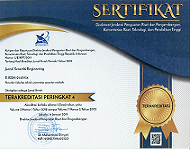The Impact of Rainfall Fluctuations on the Trophic of Maninjau Lake Based on the Carlson Index and The Comprehensive Index (CTSI)
Keywords:
maninjau lake , rainfall fluctuation , trophic status , eutrophication , comprehensive trophic state indexAbstract
Maninjau Lake is experiencing increased eutrophication levels, negatively impacting water quality and the balance of its aquatic ecosystems. One of the factors that is thought to play a role in accelerating the process is rainfall fluctuation, which affects nutrient input from the water catchment area. This study aims to analyze the effect of rainfall fluctuation on the trophic status of Maninjau Lake using the Carlson Trophic State Index (TSI) and Comprehensive Trophic State Index (CTSI) methods. Water sampling was conducted at 10 stations over three periods: September 2022, January 2023, and March 2023, which represented seasonal variations. The parameters measured included chlorophyll-a, total phosphorus (TP), total nitrogen (TN), chemical oxygen demand (COD), and Secchi depth according to national standards. Rainfall data were obtained from BMKG stations and correlated with trophic index values. Results showed TSI values ranged from 55–72 and CTSI between 60–75, indicating eutrophic to hypereutrophic conditions. The highest trophic status occurred in periods of high rainfall, with a strong positive correlation between rainfall intensity and nutrient increase (r = 0.999 for TSI; r = 0.989 for CTSI). Rainfall plays a role as the main hydrometeorological driver of trophic dynamics, so adaptive management is needed to mitigate the impact of eutrophication under climate variability.
References
[1] T. R. Soeprobowati et al., “Riparian Vegetation of Maninjau Lake, West Sumatra, Indonesia: a Study of Biodiversity and Above-Ground Carbon Stock,” Int. J. Conserv. Sci., vol. 16, no. 2, pp. 1065–1086, 2025.
[2] P. S. Komala et al., “Spatio-temporal Changes of Water Quality Based on Water Quality Index Method in Tropical Lake of Indonesia,” Water. Air. Soil Pollut., vol. 234, no. 9, Sep. 2023, doi: 10.1007/s11270-023-06599-9.
[3] C. B. De Maisonneuve et al., “Bathymetric survey of lakes Maninjau and Diatas (West Sumatra), and lake Kerinci (Jambi),” J. Phys. Conf. Ser., vol. 1185, no. 1, 2019, doi: 10.1088/1742-6596/1185/1/012001.
[4] M. Karpowicz, N. Kuczyńska-Kippen, Ł. Sługocki, R. Czerniawski, E. Bogacka-Kapusta, and J. Ejsmont-Karabin, “Trophic status index discrepancies as a tool for improving lake management: insights from 160 Polish lakes,” Sci. Total Environ., vol. 981, p. 179581, 2025, doi: https://doi.org/10.1016/j.scitotenv.2025.179581.
[5] L. Lyu et al., “Estimation of the lake trophic state index (TSI) using hyperspectral remote sensing in Northeast China,” Opt. Express, vol. 30, pp. 10329–10345, 2022, doi: 10.1364/OE.453404.
[6] C. Tang et al., “Planktonic indicators of trophic states for a shallow lake (Baiyangdian Lake, China),” Limnologica, vol. 78, no. December 2018, p. 125712, 2019, doi: 10.1016/j.limno.2019.125712.
[7] P. S. Komala, Z. Zulkarnaini, R. I. Kurniati, and M. Fauzi, “The effect of anthropogenic activities on the spatial distribution of total nitrogen and total phosphate in Lake Maninjau,” J. Water L. Dev., no. 60, pp. 71–78, 2024, doi: 10.24425/jwld.2024.149109.
[8] C.-Y. Shou, Y. Tian, B. Zhou, X.-J. Fu, Y.-J. Zhu, and F.-J. Yue, “The Effect of Rainfall on Aquatic Nitrogen and Phosphorus in a Semi-Humid Area Catchment, Northern China,” Int. J. Environ. Res. Public Health, vol. 19, p. 10962, 2022, doi: 10.3390/ijerph191710962.
[9] D. B. da Silva, V. R. Bellotto, J. D. S. B. Barbosa, and T. B. Lima, “Spatiotemporal variation on water quality and trophic state of a tropical urban reservoir: A case study of the lake paranoá-DF, Brazil,” Water (Switzerland), vol. 13, no. 22, 2021, doi: 10.3390/w13223314.
[10] L. Lukman, “Anthropogenic Impact on Lake Ecosystem,” Intech, vol. 11, no. tourism, p. 13, 2023, [Online]. Available: https://www.intechopen.com/books/advanced-biometric-technologies/liveness-detection-in-biometrics
[11] F. Sulawesty, Y. Yustiawati, and S. Aisyah, “Komunitas Fitoplankton di Daerah Litoral Danau Maninjau dan Sungai Ranggeh, Kabupaten Agam Kaitannya dengan Kandungan Nutrien,” Oseanologi dan Limnol. di Indones., vol. 5, no. 1, p. 47, Jul. 2020, doi: 10.14203/oldi.2020.v5i1.289.
[12] Q. Chen, J. Zhao, Q. Gao, H. X. Liu, and X. M. Han, “Trophic state footprint index model and its application to Dianchi Lake, China,” Ecol. Indic., vol. 132, no. August, p. 108317, 2021, doi: 10.1016/j.ecolind.2021.108317.
[13] M. Fakhrudin, H. Wibowo, L. Subehi, and I. Ridwansyah, “Karakterisasi Hidrologi Danau Maninjau Sumbar,” Pros. Semin. Nas. Limnol., no. April 2018, pp. 65–75, 2002.
[14] T. Fukushima et al., “Convection of waters in Lakes Maninjau and Singkarak, tropical oligomictic lakes,” Limnology, vol. 23, no. 2, pp. 375–383, 2022, doi: 10.1007/s10201-021-00686-8.
[15] L. Mwadzingeni, R. Mugandani, and P. Mafongoya, “Risks of Climate Change on Future Water Supply in Smallholder Irrigation Schemes in Zimbabwe,” Water (Switzerland), vol. 14, no. 11, pp. 1–20, 2022, doi: 10.3390/w14111682.
[16] D. Naderian et al., “Environmental controls on the conversion of nutrients to chlorophyll in lakes,” Water Res., vol. 274, p. 123094, Apr. 2025, doi: 10.1016/j.watres.2025.123094.
[17] E. Dindar, “Assessment of pollution status using Water Quality Index (WQI) and hydrochemical ındicators in the Gemlik Gulf, Marmara Sea, Türkiye: a spatial and temporal perspective.,” Environ. Sci. Pollut. Res. Int., vol. 32, no. 24, pp. 14860–14890, May 2025, doi: 10.1007/s11356-025-36560-8.
[18] G. Carper and R. Bachmann, “Wind Resuspension of Sediments in a Prairie Lake,” Can. J. Fish. Aquat. Sci., vol. 41, pp. 1763–1767, 2011, doi: 10.1139/f84-217.
[19] Sulastri, C. Henny, and S. Nomosatryo, “Phytoplankton diversity and trophic status of Lake Maninjau, West Sumatra, Indonesia,” Pros. Semin. Nas. Masy. Biodivsersotas Indones., vol. 5, no. 2, pp. 242–250, 2019, doi: 10.13057/psnmbi/m050217.
[20] P. S. Komala, S. Silvia, and S. Windi, “Phytoplankton Dynamics and Its Relation to Physicochemical Parameters in the Dry Season of Maninjau Lake , West Sumatra , Indonesia,” J. Ecol. Eng., vol. 24, no. 9, pp. 218–231, 2023.
[21] Y. Qi et al., “Research on the Analysis of and Countermeasures for the Eutrophication of Water Bodies: Waihu Reservoir as a Case Study,” Processes, vol. 12, no. 4, 2024, doi: 10.3390/pr12040796.
[22] Q. Chen et al., “No-linear dynamics of lake ecosystem in responding to changes of nutrient regimes and climate factors: Case study on Dianchi and Erhai lakes, China,” Sci. Total Environ., vol. 781, p. 146761, 2021, doi: 10.1016/j.scitotenv.2021.146761.
[23] J. Huang, J. Zhang, N. Wang, S. Hu, and Y. Duan, “Identification of the Driving Factors to Algal Biomass in Lake Dianchi: Implications for Eutrophication Control,” Water (Switzerland), vol. 16, no. 23, pp. 1–18, 2024, doi: 10.3390/w16233485.
[24] V. Lumbanraja and N. Nasution, “Preserving the Lake Toba ecosystem: Strategic planning to mitigate red devil fish invasion,” IOP Conf. Ser. Earth Environ. Sci., vol. 1352, p. 12057, May 2024, doi: 10.1088/1755-1315/1352/1/012057.
[25] T. D. T. Oyedotun and N. Ally, “Environmental issues and challenges confronting surface waters in South America: A review,” Environ. Challenges, vol. 3, p. 100049, 2021, doi: https://doi.org/10.1016/j.envc.2021.100049.
[26] A. B. Tilahun, H. H. Dürr, K. Schweden, and M. Flörke, “Perspectives on total phosphorus response in rivers: Examining the influence of rainfall extremes and post-dry rainfall,” Sci. Total Environ., vol. 940, p. 173677, 2024, doi: https://doi.org/10.1016/j.scitotenv.2024.173677.
[27] A. Sunaryani, “Determination of Water Quality Status and Trophic Classification of Lake Maninjau,” J. Teknol. Lingkung., vol. 24, no. 1, pp. 21–27, 2023.
Downloads
Published
Issue
Section
License
Copyright (c) 2025 Lia Arlina, Puti Sri Komala, Shinta Silvia (Author)

This work is licensed under a Creative Commons Attribution 4.0 International License.












